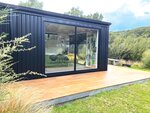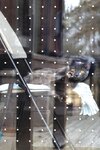By Margie O’loughlin
Cradling the Mississippi River on either side, the Twin Cities are a critical, yet hazardous, resting place for migrating birds. An estimated 40 million birds migrated through the Mississippi River flyway on their way to northern breeding grounds this spring – navigating obstacles in the human-built environment as they flew. The flyway is one of four major migratory corridors in the US.
Jeannine Thiele is the interim president of the Audubon Chapter of Minneapolis. She said, “A 2019 study revealed that North America’s bird population has declined by almost 30% since 1970. Responsible for this are climate change, habitat loss, pesticide use, cat predation, and collisions with glass.”
These mortality numbers are so big that they’re hard to wrap one’s head around. But bird deaths, at least in the last category, can be prevented one crash at a time without even leaving home.
FLY BY NIGHT
Most migratory birds travel at night, relying in part on the moon and stars to guide them. Night flying has other advantages too: the air is smoother, the temperatures cooler, and the predators fewer. But there is one huge disadvantage – artificial light attracts and confuses birds. When they see it, birds often crash into wherever the light is coming from: houses, office towers, transit shelters, car windows, greenhouses, solariums, and skyways. Collisions with windows on homes are about as frequent as collisions with those on office towers.
So, what can one person do? Close your curtains at night, especially during the migration season, to reduce light spread. And give consideration to your choice of outdoor lighting. Beams of light should only be directed downward, never up into trees, and used minimally as safety needs require.
FLY BY DAY
Daytime flight has its challenges too. Thiele said, “Birds can’t interpret glass. They ‘see’ the reflections of trees, shrubs, and open skies as real – and try to fly on through. A bird’s first interaction with glass is usually fatal, so there isn’t much opportunity for learning. Migrating and juvenile birds are especially susceptible to window strikes.”
Thiele continued, “Glass looks transparent, reflective, or dark to birds depending on available light. Markers placed on the outside surface of windows makes glass visible to them, while still being transparent to the human eye. Markers placed inside windows are not nearly as effective.”
Research from the American Bird Conservancy (ABC) has shown that birds will not fly through spaces less than two inches high and two inches wide. This is the recommended spacing for marking windows to help birds “see” glass, and there are a variety of products to choose from.
MAKE YOUR OWN BIRD-SAFE GLASS
Feather Friendly (www.featherfriendly.com) is a Canadian company that has been designing window markings to prevent bird collisions since 2006. Visit the small-scale DIY section on their website to see a variety of adhesive products that can be applied to home windows.
In partnership with Feather Friendly, the American Bird Conservancy offers a product called ABC Bird Tape. The white or light blue vinyl tape can be applied to windows in long strips or patterns of squares. The tape lasts an average of four years, and is translucent enough to let natural light through.
Acopian Bird Savers (www.acopianbirdsavers.org) are a simple solution made of parachute cord hung in two-inch strips across the width of a window. Note that cord should be cut longer than window length, as rain will cause cord shrinkage. Acopian Bird Savers can be purchased ready-made through their website, or you can make them yourself.
And the most economical solution of all? Apply tempera paint (available at most art supply and craft stores) free-hand with a brush or sponge, or use a stencil. Tempera paint is long-lasting, rain-proof and non-toxic, but wipes off easily with a damp rag and a little elbow-grease.
The hawk decals many of us thought were sufficient for alerting birds don’t work, it turns out. If you have a window or windows prone to bird strikes, try one of these other methods to prevent bird deaths at home.


Comments
No comments on this item Please log in to comment by clicking here